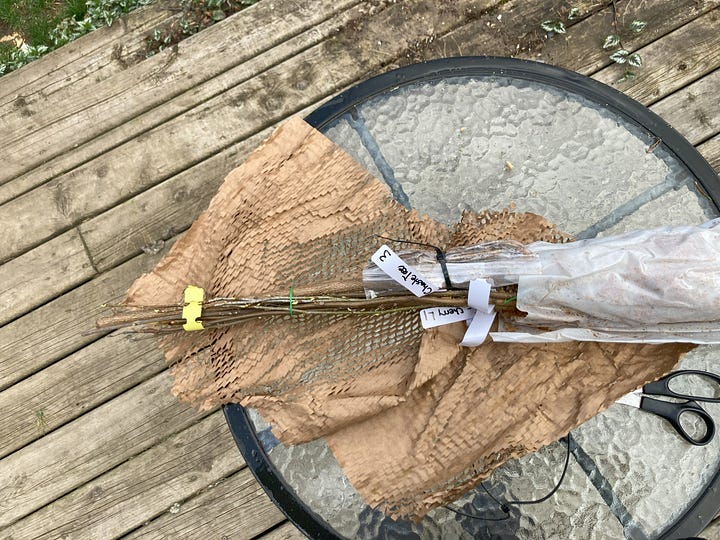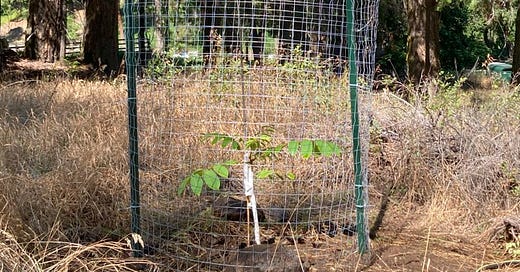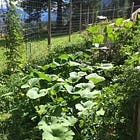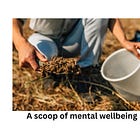Starting a Food Forest (What, How, Why and When)
Most people underestimate what they can do in 10 years
There is no question that forests are good for us – good for the air we breathe, the reconnection to nature we find in them, and the mental re-set we gain.
Forests can also be a perpetual source of food. We have just largely stopped thinking about them in this way.
We have orchards and gardens instead. But these food growing efforts are not the same thing as a food forest.
Whether you have acres to fill, or simply a backyard, the principles of creating food forests offer us something a little be different, something a little bit wilder, to work with.
So let’s explore what a food forest is why it can change your perspective on food security and abundance. Spring time is the perfect time to start thinking about planting trees!
What is a food forest and how are they created?
A forest is a landscape that is dominated by trees. Therefore, a food forest is a landscape dominated by food-producing trees. It’s that simple.
Trees give us that additional vertical space in which to grow food, often producing hundreds of pounds of food per tree once matured. Trees create shade and vertical complexity in our systems, which multiples the number of plants and animals that can become associated with this food forest space. I have written before about the importance of biodiversity for reducing pests, and increasing our food production.
Conventional agriculture doesn’t look like a food forest. Every tree, shrub, stick and rock is stripped from a field before planting it to the crop species. This strategy is usually applied to orchards as well, with row upon row of meticulously groomed trees usually with little else as “competition” (aka - no understory in sight).
By contrast, forests have many layers. They may be as simple as ground cover, shrub and tree layers (3 levels) and as complex as multiple categories of each with the addition of vines, climbers, epiphytes, and other plants thrown into the mix.
Commercialized food production and “efficiency” has driven us away from ecological ways in which to produce more food. Carving out some space for a food forest simply makes a lot of sense if you are planning for tomorrow.
Food forest follow the ‘jar of life’ principle
The best analogy of a food forest for me comes by comparing it to the ‘jar of life’ video. Do you remember that one?
It’s where a jar represents the time you have and what you choose to fill the jar with determines if you have room in your life for major priorities (rocks) or whether you spend all your time on the details (sand). If you focus first on your priorities (start with the rocks), you will discover there is room in the jar for more things than you can imagine. You can watch the video here: “Jar of Life” video .
Now let’s say the jar is your landscape and the rocks are trees, the gravel is shrubs and the sand is ground crops. Most of our modern agriculture practices fill the jar with just one thing – just sand, just gravel, just rocks. But the diversified food forest allows us to have all three layers working, all three layers can “fit in the jar” and our capacity to grow food is greatly enhanced.
You create a food forest by using food trees to establish your landscape framework. Then you fill in the layers below that canopy with food and medicine producing plants that will thrive in the sun and shade created between and below the trees.
Why food forests are important
In so many ways, food forests create a fail-safe in an increasingly unpredictable world.
Based on perennial plants, these systems have more resilience to come back after adversity than annual food crops which are one and done, and wiped out within a single season during disaster. Food forests are much easier to “naturalize” which essentially means ‘to become native, to adapt’ to the location you move to. This can add a layer of resilience to the question of food security.
There is also an added bonus to the food forest model that often gets overlooked. Many of the trees and shrubs in these systems will produce food year after year with less and less effort required by the grower/forest steward. More food and less work is a win-win.
When to create a food forest?
The old saying goes, the best time to plant a tree was 10 years ago and the second best time is right now.
Plant trees this year!
Most people underestimate what they can accomplish in 10 years. It seems too far away. But in 10 years a food forest is flourishing. And many food producing trees starting giving you something in as little as 3 to 4 years.
Start now.
My food forest adventure
I began seriously contemplating a food forest a few years ago, but my first (3) heartnut trees finally went into the ground last fall.
They’ve got a lot to contend with - mostly deer and drought being the two biggest threats in my area. But I finally got started all the same. They seem very tiny right now. But in just a few short years the first heartnuts (a Japanese walnut variety) will form, and eventually these trees will be providing food that can be easily stored all winter long.
As these trees grow, I will be adding more shrubs and ground covers to start filling in this space with food and medicine. There are already native Saskatoons and Oregon grapes nearby. Meadow arnica, Valarian, Highbush cranberry, and Elderberry are great choices that are in the works.
A new shipment of bareroot trees from Zero Fox Tree Nursery arrived last week. It is so strange to hold a future forest like a wand in your hand.
The bareroot trees come wrapped up tight, and arrive safe and sound. It is bizarre and wonderful. For the most part, smaller bareroot trees are cheaper than huge 3-5 ft nursery stock and they usually catch up to those trees fast because they haven’t gone through severe root trimming and potting.


This shipment included 3 Butternuts, 3 Chasteberry, 1 Gingko, 1 Sour cherry and 5 Meadow arnica. What fun!
Slowly but surely my plan is to add various nut, food and medicinal plants around the farm, to build food security (and potentially to create a retirement income from the nuts!).
I am spreading these trees in clusters around the farm, in part to fit them into an existing old forest, and in part to spread the risk of any one patch being subject to external factors.
I am also experimenting with Hardy pecan trees, started from seed. So far it looks like all 5 that sprouted and grew last year have made it through the winter in my unheated work room. We will see how they grow this year. If they gain some good size, they too might get planted out before fall. Stay tuned.
Time well spent
Somehow, we wake up one day and we are now 40 or 50 or 60 or? Time just seems to get away from us. I bought this small farm in Dec of 2012. . . . and it’s suddenly 2025 this year. Where does the time go?
Had I started on the food forest that first summer, my trees would already be feeding me and my neighbors. But back then I was busy settling in and getting my bearings. It doesn’t mean that now isn’t a great time to get started, all the same.
While I was reading and learning about food forests and permaculture, I have to admit feeling paralyzed for a few years by the complexity of the concepts being presented. It honestly felt like too much pressure trying to “get it right the first time”.
I eventually had to just let that nonsense go. The reality is forests grow all around us. Some trees grow in the most unlikely and harshest conditions, straight out of rocks on a cliff side even. The idea of making “mistakes” with the food forest was preventing me from creating a food forest.
I took a deep breath and dug that first hole. And the rest will be history.
You may not have a ton of space to work with. Like me, you may have never done this before. But even having one tree and a few shrubs is a great way to create food doing less work over time.
Food forests let us step outside of the box of conventional food thinking, and go back to something a little bit wilder, and a lot more productive. Working with sun and shade, canopy and understory, opens up a world of diversity and resilience.
It’s one more way to let some wild back in, and now is as good a time as there ever was.
Happy growing.
The Naturalized Human brings together the science and human experience of the mind-body-food connection. I hope you stick around and become part of this community seeking to understand how the food we eat, and the environments we live in, impact everything about our minds and bodies.
More to read:









I love food forests!!! We purchased a lot last summer and I just want to get out there and plant trees!! As a Herbalist I want to focus on medicinal trees that will grow here (I'm in southern Manitoba) but aren't found in local forests. I can't wait to get started.
Ps: have you heard of Forest Garden Greenhouses? As a prairie girl, I love the idea. . .someday, when I'm rich. 😂
I just looked up "Best food forest trees and shrubs for zone 9." I live in a neighborhood with an HOA, but I can get away with semi-wild agriculture. I love this perspective and thinking of ways I can add more food to my little patch of Earth. I'm looking at options for blueberries where we took out the shrubs along the side of the house. Thanks for the idea!